Millennials in the Workplace: Forces, Changes, and Boomers
VerifiedAdded on 2022/08/17
|5
|1136
|12
Case Study
AI Summary
This case study examines the evolving dynamics of the workplace, particularly focusing on the impact of Millennials. It analyzes the forces driving change, including shifts in compensation, benefits, and work-life balance preferences compared to previous generations like Baby Boomers. The study explores structural changes within organizations, such as the adoption of result-oriented work environments and personalized benefit suites, to accommodate the needs of a diverse workforce. It also investigates the perspectives and influence of Baby Boomers, highlighting their cautious approach to organizational changes and the impact of economic factors on their attitudes. The conclusion emphasizes the challenges and opportunities of managing a multi-generational workforce, advocating for strategic plans that foster learning and integration among different generations to leverage valuable insights and experiences.
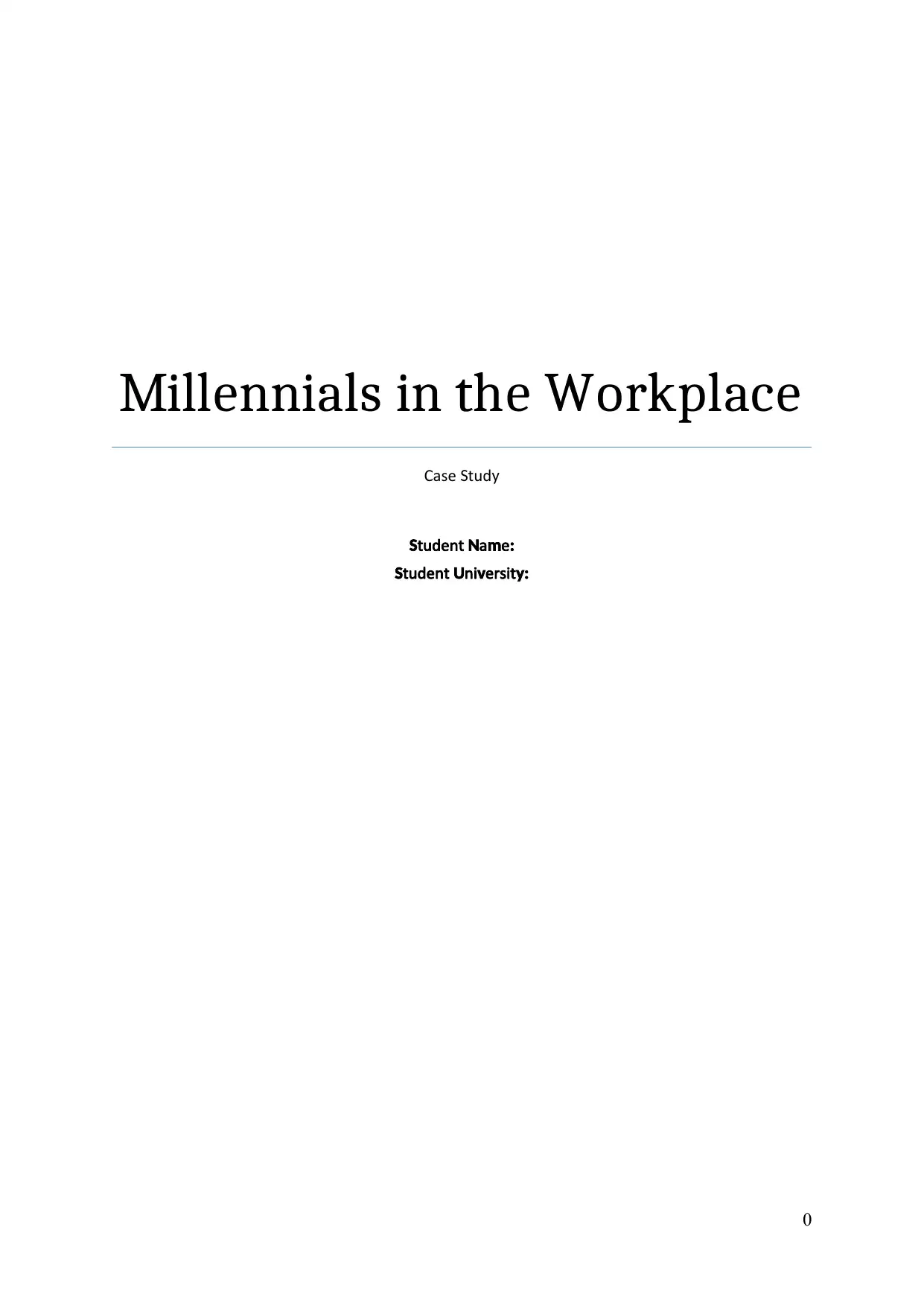
Millennials in the Workplace
Case tudS y
tudent a eS N m :
tudent ni ersitS U v y:
0
Case tudS y
tudent a eS N m :
tudent ni ersitS U v y:
0
Paraphrase This Document
Need a fresh take? Get an instant paraphrase of this document with our AI Paraphraser
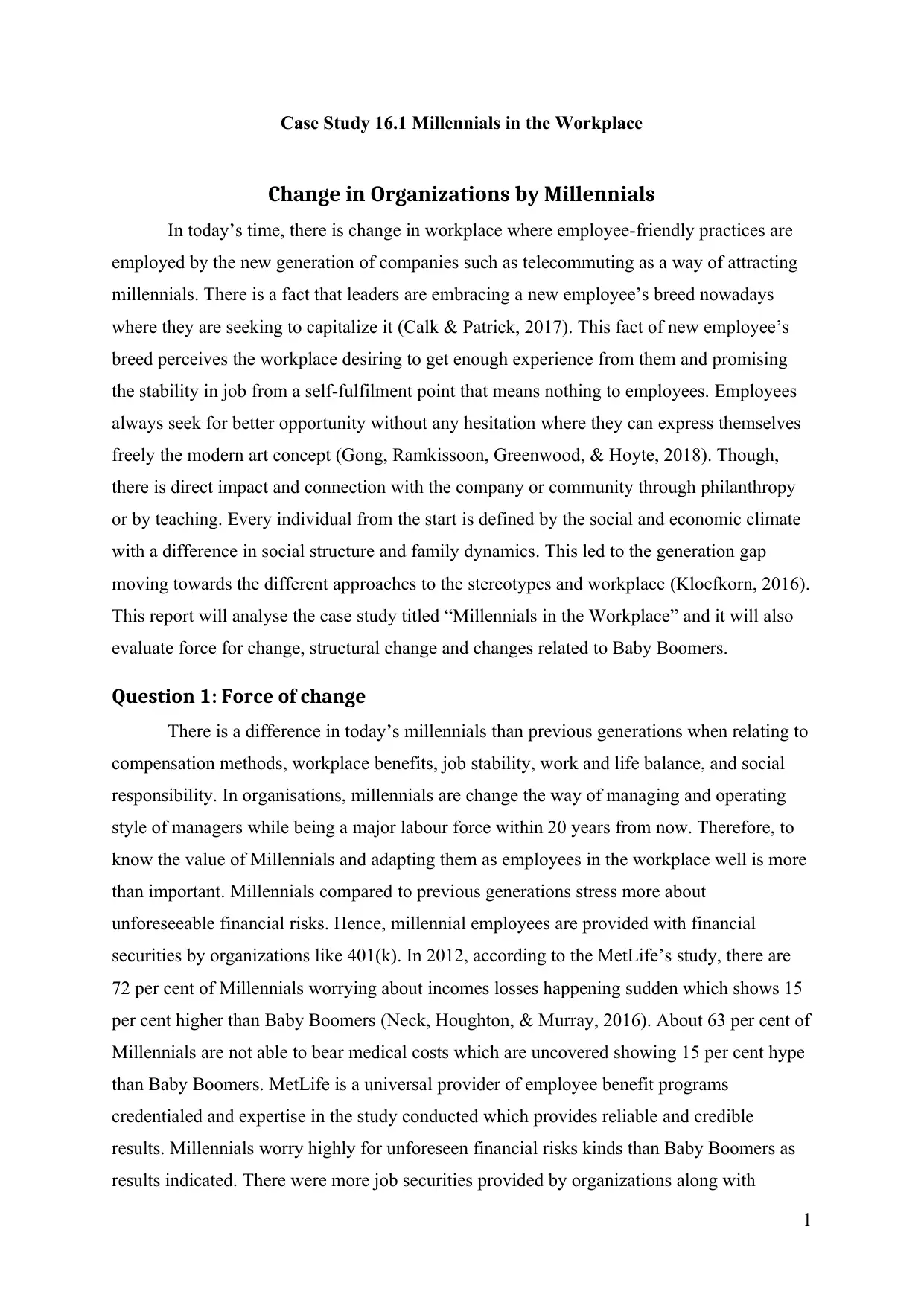
Case Study 16.1 Millennials in the Workplace
Change in Organizations by Millennials
In today’s time, there is change in workplace where employee-friendly practices are
employed by the new generation of companies such as telecommuting as a way of attracting
millennials. There is a fact that leaders are embracing a new employee’s breed nowadays
where they are seeking to capitalize it (Calk & Patrick, 2017). This fact of new employee’s
breed perceives the workplace desiring to get enough experience from them and promising
the stability in job from a self-fulfilment point that means nothing to employees. Employees
always seek for better opportunity without any hesitation where they can express themselves
freely the modern art concept (Gong, Ramkissoon, Greenwood, & Hoyte, 2018). Though,
there is direct impact and connection with the company or community through philanthropy
or by teaching. Every individual from the start is defined by the social and economic climate
with a difference in social structure and family dynamics. This led to the generation gap
moving towards the different approaches to the stereotypes and workplace (Kloefkorn, 2016).
This report will analyse the case study titled “Millennials in the Workplace” and it will also
evaluate force for change, structural change and changes related to Baby Boomers.
Question 1: Force of change
There is a difference in today’s millennials than previous generations when relating to
compensation methods, workplace benefits, job stability, work and life balance, and social
responsibility. In organisations, millennials are change the way of managing and operating
style of managers while being a major labour force within 20 years from now. Therefore, to
know the value of Millennials and adapting them as employees in the workplace well is more
than important. Millennials compared to previous generations stress more about
unforeseeable financial risks. Hence, millennial employees are provided with financial
securities by organizations like 401(k). In 2012, according to the MetLife’s study, there are
72 per cent of Millennials worrying about incomes losses happening sudden which shows 15
per cent higher than Baby Boomers (Neck, Houghton, & Murray, 2016). About 63 per cent of
Millennials are not able to bear medical costs which are uncovered showing 15 per cent hype
than Baby Boomers. MetLife is a universal provider of employee benefit programs
credentialed and expertise in the study conducted which provides reliable and credible
results. Millennials worry highly for unforeseen financial risks kinds than Baby Boomers as
results indicated. There were more job securities provided by organizations along with
1
Change in Organizations by Millennials
In today’s time, there is change in workplace where employee-friendly practices are
employed by the new generation of companies such as telecommuting as a way of attracting
millennials. There is a fact that leaders are embracing a new employee’s breed nowadays
where they are seeking to capitalize it (Calk & Patrick, 2017). This fact of new employee’s
breed perceives the workplace desiring to get enough experience from them and promising
the stability in job from a self-fulfilment point that means nothing to employees. Employees
always seek for better opportunity without any hesitation where they can express themselves
freely the modern art concept (Gong, Ramkissoon, Greenwood, & Hoyte, 2018). Though,
there is direct impact and connection with the company or community through philanthropy
or by teaching. Every individual from the start is defined by the social and economic climate
with a difference in social structure and family dynamics. This led to the generation gap
moving towards the different approaches to the stereotypes and workplace (Kloefkorn, 2016).
This report will analyse the case study titled “Millennials in the Workplace” and it will also
evaluate force for change, structural change and changes related to Baby Boomers.
Question 1: Force of change
There is a difference in today’s millennials than previous generations when relating to
compensation methods, workplace benefits, job stability, work and life balance, and social
responsibility. In organisations, millennials are change the way of managing and operating
style of managers while being a major labour force within 20 years from now. Therefore, to
know the value of Millennials and adapting them as employees in the workplace well is more
than important. Millennials compared to previous generations stress more about
unforeseeable financial risks. Hence, millennial employees are provided with financial
securities by organizations like 401(k). In 2012, according to the MetLife’s study, there are
72 per cent of Millennials worrying about incomes losses happening sudden which shows 15
per cent higher than Baby Boomers (Neck, Houghton, & Murray, 2016). About 63 per cent of
Millennials are not able to bear medical costs which are uncovered showing 15 per cent hype
than Baby Boomers. MetLife is a universal provider of employee benefit programs
credentialed and expertise in the study conducted which provides reliable and credible
results. Millennials worry highly for unforeseen financial risks kinds than Baby Boomers as
results indicated. There were more job securities provided by organizations along with
1
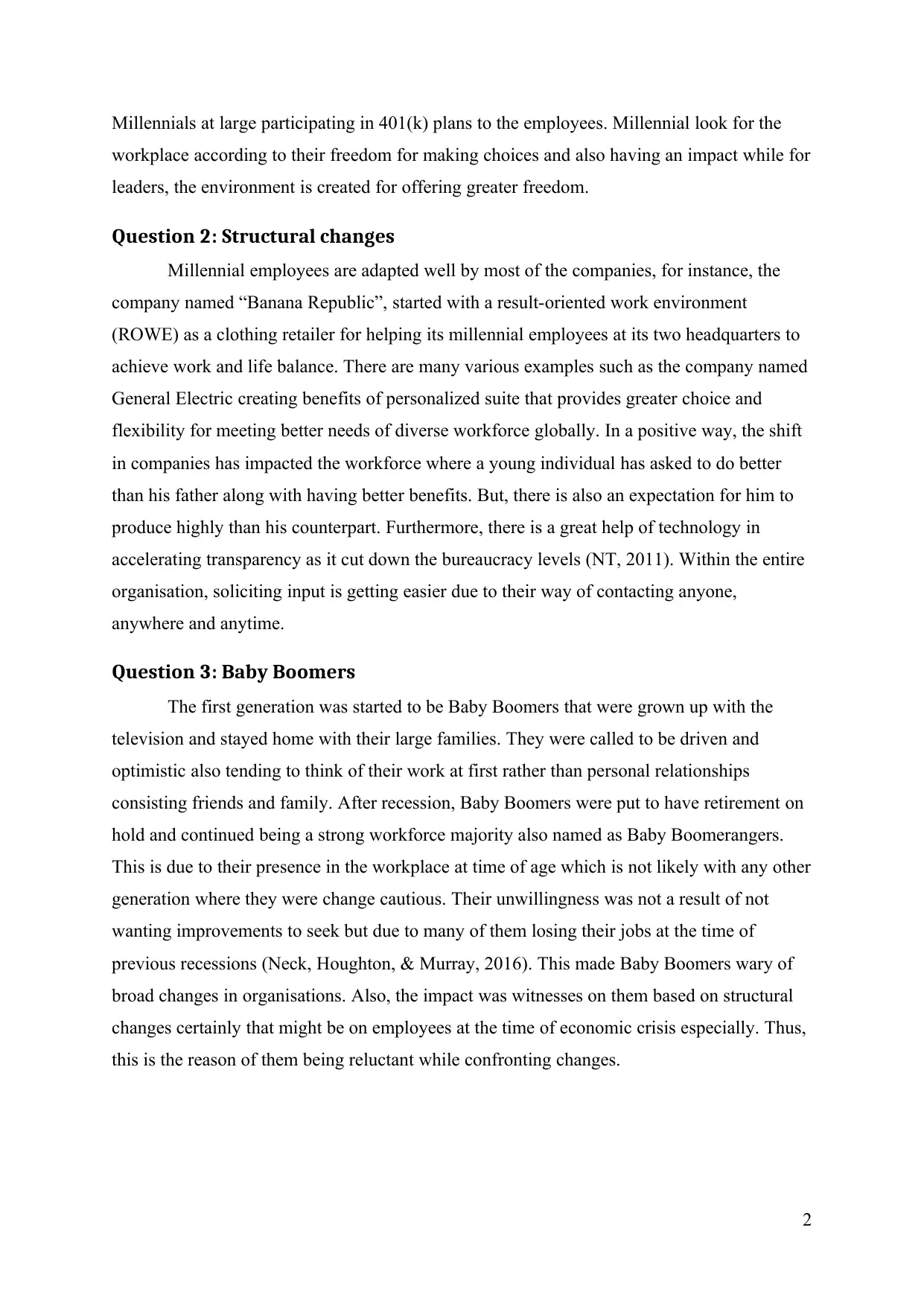
Millennials at large participating in 401(k) plans to the employees. Millennial look for the
workplace according to their freedom for making choices and also having an impact while for
leaders, the environment is created for offering greater freedom.
Question 2: Structural changes
Millennial employees are adapted well by most of the companies, for instance, the
company named “Banana Republic”, started with a result-oriented work environment
(ROWE) as a clothing retailer for helping its millennial employees at its two headquarters to
achieve work and life balance. There are many various examples such as the company named
General Electric creating benefits of personalized suite that provides greater choice and
flexibility for meeting better needs of diverse workforce globally. In a positive way, the shift
in companies has impacted the workforce where a young individual has asked to do better
than his father along with having better benefits. But, there is also an expectation for him to
produce highly than his counterpart. Furthermore, there is a great help of technology in
accelerating transparency as it cut down the bureaucracy levels (NT, 2011). Within the entire
organisation, soliciting input is getting easier due to their way of contacting anyone,
anywhere and anytime.
Question 3: Baby Boomers
The first generation was started to be Baby Boomers that were grown up with the
television and stayed home with their large families. They were called to be driven and
optimistic also tending to think of their work at first rather than personal relationships
consisting friends and family. After recession, Baby Boomers were put to have retirement on
hold and continued being a strong workforce majority also named as Baby Boomerangers.
This is due to their presence in the workplace at time of age which is not likely with any other
generation where they were change cautious. Their unwillingness was not a result of not
wanting improvements to seek but due to many of them losing their jobs at the time of
previous recessions (Neck, Houghton, & Murray, 2016). This made Baby Boomers wary of
broad changes in organisations. Also, the impact was witnesses on them based on structural
changes certainly that might be on employees at the time of economic crisis especially. Thus,
this is the reason of them being reluctant while confronting changes.
2
workplace according to their freedom for making choices and also having an impact while for
leaders, the environment is created for offering greater freedom.
Question 2: Structural changes
Millennial employees are adapted well by most of the companies, for instance, the
company named “Banana Republic”, started with a result-oriented work environment
(ROWE) as a clothing retailer for helping its millennial employees at its two headquarters to
achieve work and life balance. There are many various examples such as the company named
General Electric creating benefits of personalized suite that provides greater choice and
flexibility for meeting better needs of diverse workforce globally. In a positive way, the shift
in companies has impacted the workforce where a young individual has asked to do better
than his father along with having better benefits. But, there is also an expectation for him to
produce highly than his counterpart. Furthermore, there is a great help of technology in
accelerating transparency as it cut down the bureaucracy levels (NT, 2011). Within the entire
organisation, soliciting input is getting easier due to their way of contacting anyone,
anywhere and anytime.
Question 3: Baby Boomers
The first generation was started to be Baby Boomers that were grown up with the
television and stayed home with their large families. They were called to be driven and
optimistic also tending to think of their work at first rather than personal relationships
consisting friends and family. After recession, Baby Boomers were put to have retirement on
hold and continued being a strong workforce majority also named as Baby Boomerangers.
This is due to their presence in the workplace at time of age which is not likely with any other
generation where they were change cautious. Their unwillingness was not a result of not
wanting improvements to seek but due to many of them losing their jobs at the time of
previous recessions (Neck, Houghton, & Murray, 2016). This made Baby Boomers wary of
broad changes in organisations. Also, the impact was witnesses on them based on structural
changes certainly that might be on employees at the time of economic crisis especially. Thus,
this is the reason of them being reluctant while confronting changes.
2
⊘ This is a preview!⊘
Do you want full access?
Subscribe today to unlock all pages.

Trusted by 1+ million students worldwide
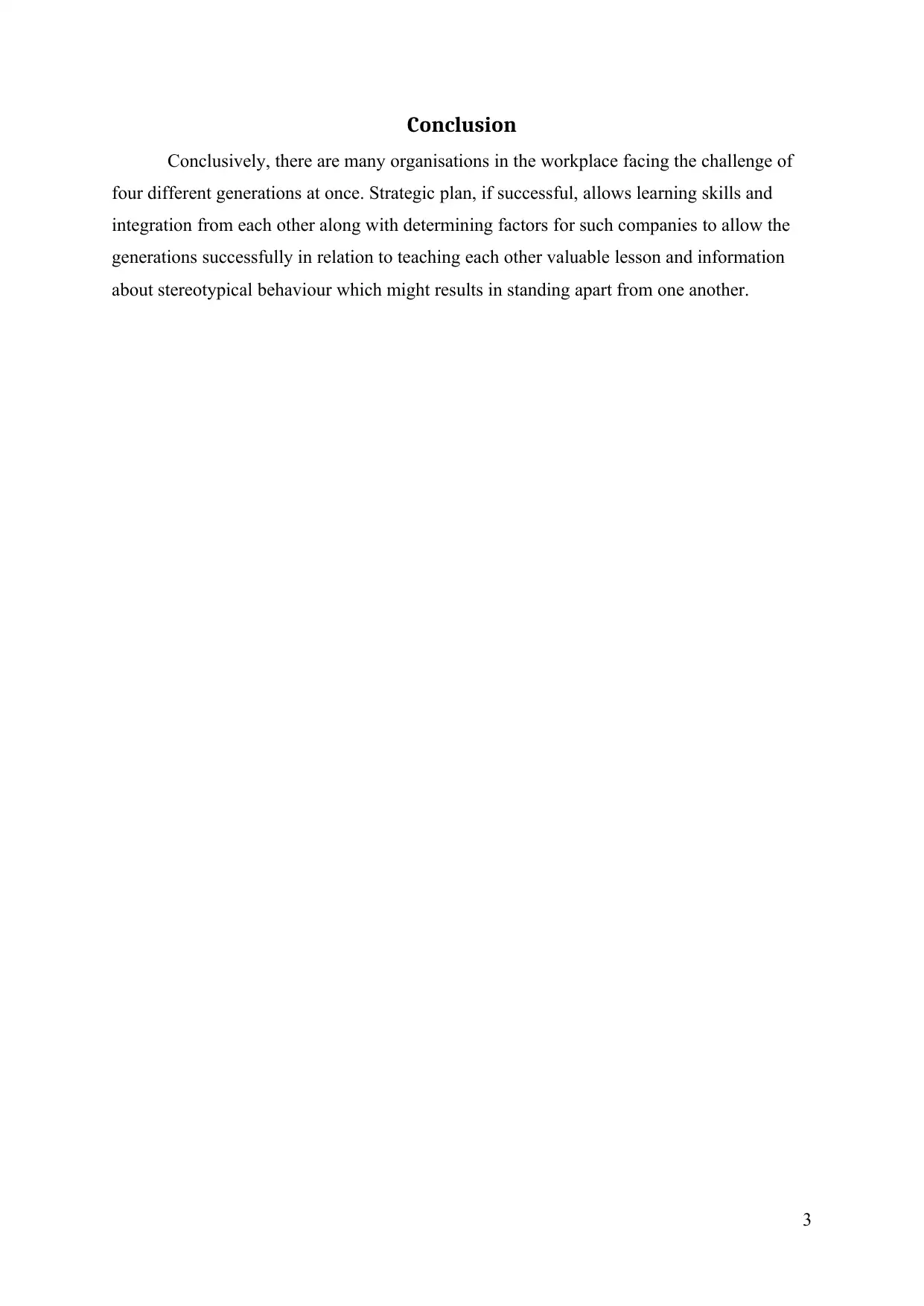
Conclusion
Conclusively, there are many organisations in the workplace facing the challenge of
four different generations at once. Strategic plan, if successful, allows learning skills and
integration from each other along with determining factors for such companies to allow the
generations successfully in relation to teaching each other valuable lesson and information
about stereotypical behaviour which might results in standing apart from one another.
3
Conclusively, there are many organisations in the workplace facing the challenge of
four different generations at once. Strategic plan, if successful, allows learning skills and
integration from each other along with determining factors for such companies to allow the
generations successfully in relation to teaching each other valuable lesson and information
about stereotypical behaviour which might results in standing apart from one another.
3
Paraphrase This Document
Need a fresh take? Get an instant paraphrase of this document with our AI Paraphraser
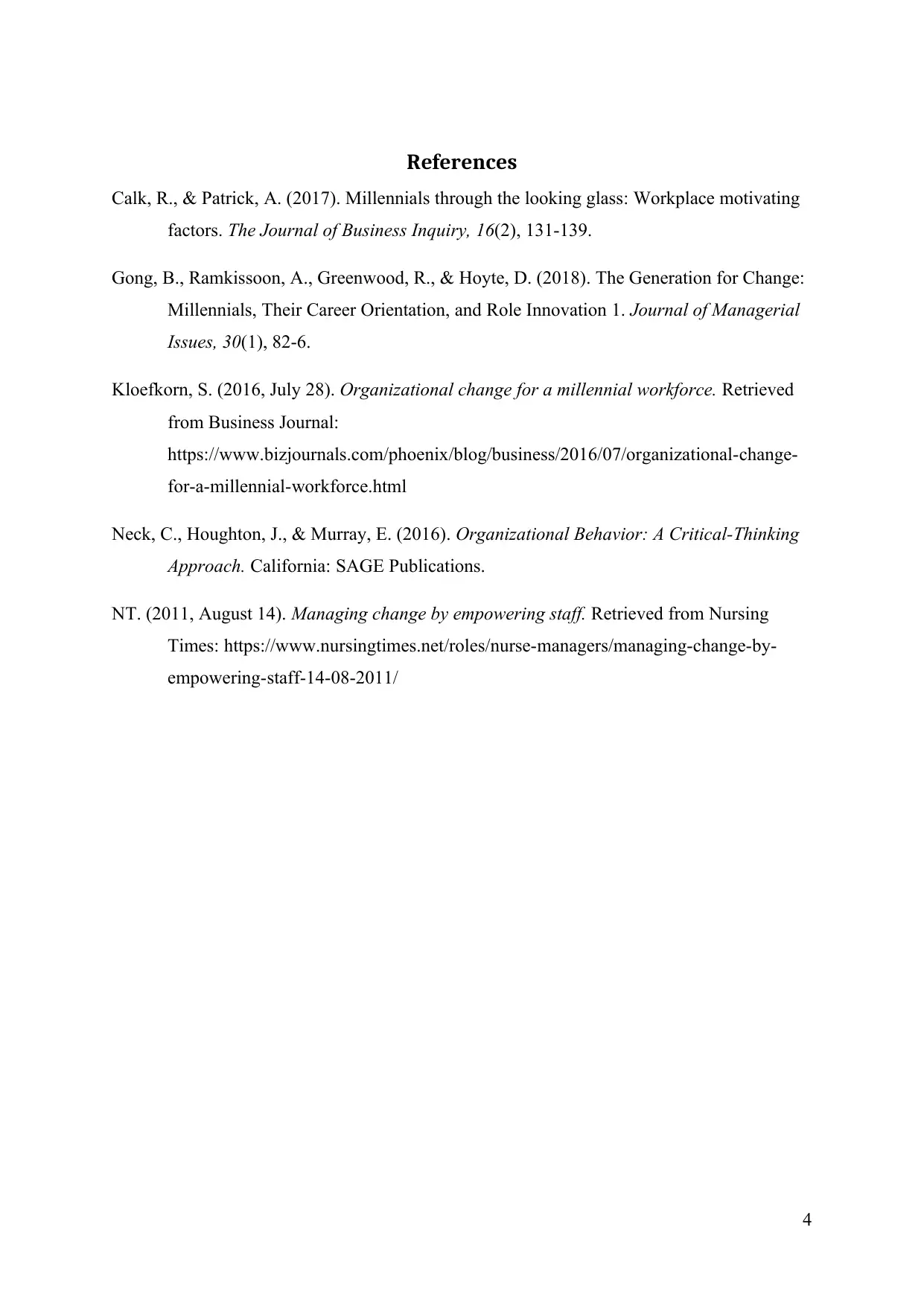
References
Calk, R., & Patrick, A. (2017). Millennials through the looking glass: Workplace motivating
factors. The Journal of Business Inquiry, 16(2), 131-139.
Gong, B., Ramkissoon, A., Greenwood, R., & Hoyte, D. (2018). The Generation for Change:
Millennials, Their Career Orientation, and Role Innovation 1. Journal of Managerial
Issues, 30(1), 82-6.
Kloefkorn, S. (2016, July 28). Organizational change for a millennial workforce. Retrieved
from Business Journal:
https://www.bizjournals.com/phoenix/blog/business/2016/07/organizational-change-
for-a-millennial-workforce.html
Neck, C., Houghton, J., & Murray, E. (2016). Organizational Behavior: A Critical-Thinking
Approach. California: SAGE Publications.
NT. (2011, August 14). Managing change by empowering staff. Retrieved from Nursing
Times: https://www.nursingtimes.net/roles/nurse-managers/managing-change-by-
empowering-staff-14-08-2011/
4
Calk, R., & Patrick, A. (2017). Millennials through the looking glass: Workplace motivating
factors. The Journal of Business Inquiry, 16(2), 131-139.
Gong, B., Ramkissoon, A., Greenwood, R., & Hoyte, D. (2018). The Generation for Change:
Millennials, Their Career Orientation, and Role Innovation 1. Journal of Managerial
Issues, 30(1), 82-6.
Kloefkorn, S. (2016, July 28). Organizational change for a millennial workforce. Retrieved
from Business Journal:
https://www.bizjournals.com/phoenix/blog/business/2016/07/organizational-change-
for-a-millennial-workforce.html
Neck, C., Houghton, J., & Murray, E. (2016). Organizational Behavior: A Critical-Thinking
Approach. California: SAGE Publications.
NT. (2011, August 14). Managing change by empowering staff. Retrieved from Nursing
Times: https://www.nursingtimes.net/roles/nurse-managers/managing-change-by-
empowering-staff-14-08-2011/
4
1 out of 5
Your All-in-One AI-Powered Toolkit for Academic Success.
+13062052269
info@desklib.com
Available 24*7 on WhatsApp / Email
![[object Object]](/_next/static/media/star-bottom.7253800d.svg)
Unlock your academic potential
Copyright © 2020–2025 A2Z Services. All Rights Reserved. Developed and managed by ZUCOL.
